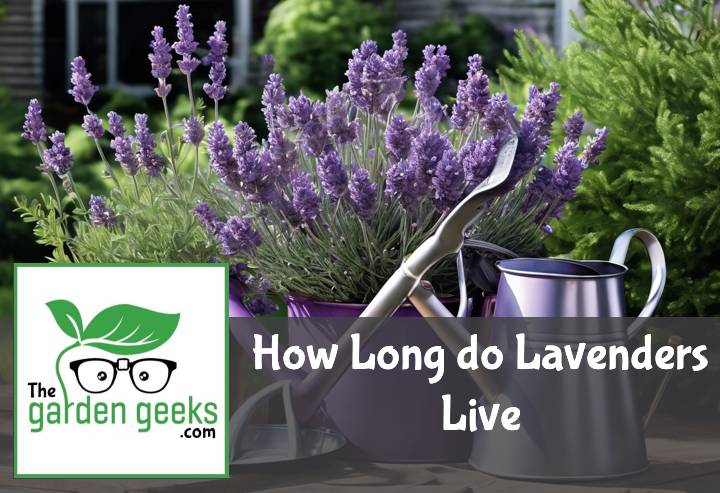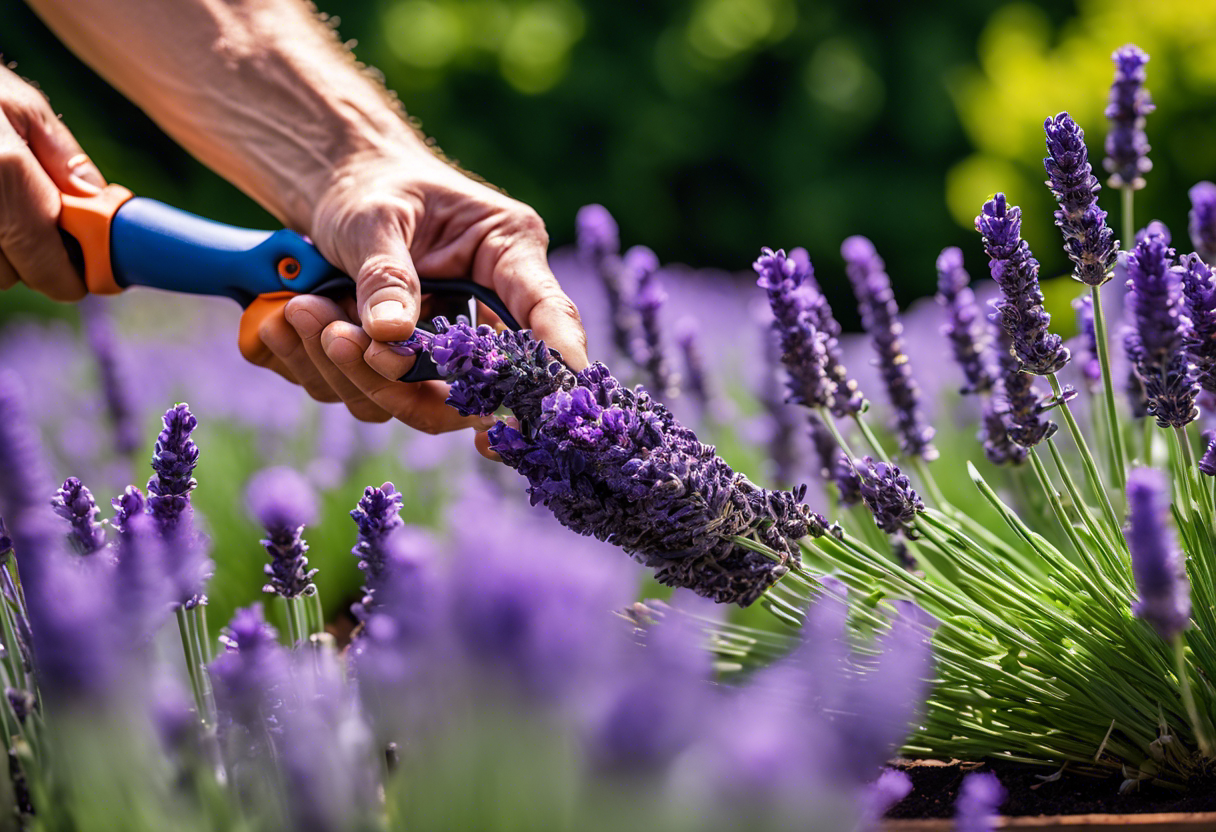Ever found yourself standing in your garden, admiring the purple hues of your lavender plants and thought, How Long do Lavenders Live? Well, you’re not alone! This question has been asked by many green thumbs around the world.
In this post, we’ll delve into the lifespan of these fragrant beauties and share some top-notch hacks to help your lavenders live longer. So buckle up plant enthusiasts, it’s time to give your lavenders a long and healthy life they deserve! Keep reading about ‘How Long do Lavenders Live? (5 Hacks to Increase Longevity)’.
Key Takeaways
- Lavenders typically live for about 10 to 15 years.
- Their lifespan can be extended by proper care, including well-drained soil, full sun exposure, and regular pruning.
- Overwatering or poor drainage can lead to root rot, shortening their life.
- Lavenders are drought-tolerant; watering once or twice a week is sufficient.
- Regular pruning after flowering promotes growth and increases longevity.
Understanding Lavender Lifespan
When it comes to the lavender plant lifespan, there’s a bit of variation. Just like us humans, these purple beauties have their own life expectancy. The longevity of lavender can be quite impressive, with some species living up to 15 years or more! Now that’s what I call enduring!
What is the Average Lifespan of a Lavender Plant?
So, you might be wondering, “What’s the average lifespan of lavender?” Well, under ideal conditions, these fragrant plants typically live between 10 and 15 years. That’s right! Your lavender could potentially stick around for over a decade. But remember, this is under perfect circumstances – we’re talking top-notch soil and just the right amount of sunlight.
However, don’t get too comfy thinking your lavender will automatically hit that 15-year mark. The typical lavender life duration can vary depending on several factors. Some lavenders may only make it to their fifth birthday if conditions aren’t ideal. So while the usual longevity for lavenders is pretty decent, it’s not set in stone.
Factors Influencing Lavender Lifespan
Now let’s talk about those pesky variables that can affect how long lavenders live. First up is soil type. Lavenders are pretty picky when it comes to their dirt bed. They prefer well-drained soil – think sandy or gravelly types.
Next up is climate. These plants love themselves some sunshine and mild winters. Too much cold can send them packing early! And lastly, care practices play a significant role in the determinants of lavender lifespan.
Overwatering? Not good for them at all! Neglecting pruning? Also not great! So if you want your lavender to live its best (and longest) life possible, pay attention to these elements impacting lavender’s life duration. Remember, a little love and care go a long way!
How to Increase Lavender Longevity: 5 Hacks
Ever wondered how long do lavenders live? Well, it’s all in the care, folks! Let’s dive into five key areas – watering, soil conditions, pruning, pest control and sunlight/temperature conditions. These are your golden tickets to increasing lavender lifespan.
Hack 1: Proper Watering Techniques
Watering is a biggie when it comes to lavender care tips. Too much or too little can spell disaster for these beauties. Overwatering can lead to root rot while underwatering leaves them parched and stressed.
The trick is finding that sweet spot of just enough water. This balance is crucial for optimal watering for lavender longevity. So remember folks, don’t drown ’em but don’t leave ’em thirsty either!
Hack 2: Ideal Soil Conditions for Lavenders
Next up on our list of lavender plant hacks is soil conditions. Lavenders love well-drained soil with a neutral to slightly alkaline pH level.
This type of soil helps prevent root rot and promotes healthy growth, both key factors in the longevity of lavender plants. So if you want happy lavenders, give them the right dirt!
Hack 3: Pruning and Maintenance Tips
Pruning isn’t just about making your lavenders look pretty (although they do clean up nice!). It’s also about maintaining their health and extending their life.
Regular pruning helps promote new growth and prevents disease spread. So grab those shears and start snipping! Your lavenders will thank you by living longer.
Hack 4: Pest Control and Disease Prevention
Pests are like unwanted house guests for your lavenders – they just won’t leave! But with proper pest control measures, you can keep these critters at bay.
Preventing diseases is another key aspect of maintaining healthy lavenders. A sickly lavender is a short-lived one, so keep an eye out for any signs of disease!
Hack 5: Optimal Sunlight and Temperature Conditions
Last but not least, let’s talk about sunlight and temperature. Lavenders love the sun, but too much heat can be harmful.
The ideal conditions are full sun exposure with moderate temperatures. This helps them grow strong and live long. So remember folks, when it comes to lavenders – let there be light (but not too hot)!
Common Mistakes that Shorten Lavender Lifespan
Alright, let’s dive into some common lavender care mistakes that can end up reducing lavender lifespan. We’re talking about improper watering, poor soil quality, and incorrect pruning. And oh boy, don’t even get me started on ignoring signs of pests or diseases!
Overwatering or Underwatering
First off, let’s chat about watering. You see, lavenders aren’t too keen on being overwatered or underwatered. Both can send them to an early grave!
Overdoing it with the water can lead to root rot. On the flip side, not giving them enough can leave them parched and struggling to survive. So what’s the secret? Well, it’s all about finding a balance.
The key is optimal lavender watering practices. Water deeply but infrequently and always ensure good drainage.
Poor Soil Quality
Next up on our list of no-nos is poor soil quality. Lavenders are pretty picky when it comes to their dirt bed!
Poor soil conditions can stunt growth and reduce lifespan dramatically. But fear not! Improving your soil isn’t rocket science.
You want well-draining soil with a neutral to slightly alkaline pH level for these purple beauties. Adding organic matter or sand can help improve drainage and create those ideal lavender soil conditions.
Neglecting Pruning or Over-pruning
Now onto pruning – a task many gardeners dread! But trust me; it’s crucial if you want your lavenders to live long and prosper.
Neglecting to prune means your plant gets woody and leggy – not a good look! On the other hand, over-pruning can cause stress and damage your plant.
So what’s the solution? It’s all about moderation folks! A little snip here and there during late summer or early fall is all it takes. Remember, correct lavender pruning techniques are your friend!
Ignoring Signs of Pests or Diseases
Last but certainly not least, don’t ignore signs of pests or diseases. These little buggers can wreak havoc on your lavenders if left unchecked.
Common culprits include aphids, whiteflies, and various fungal diseases. Spotting these early and taking action can save your plant’s life.
So there you have it folks! Avoid these common mistakes and you’ll be well on your way to answering the question: “How Long do Lavenders Live?“.
To Wrap Up
Well, there you have it folks! Like a well-loved classic car, lavenders can go the distance with a little TLC. By following our five hacks, you’ll be giving your lavender plant its own fountain of youth. So remember, don’t just ask ‘How Long do Lavenders Live‘, make it live longer!
So get out there and start nurturing your little purple beauties. After all, who doesn’t want their garden smelling like heaven for years to come?





